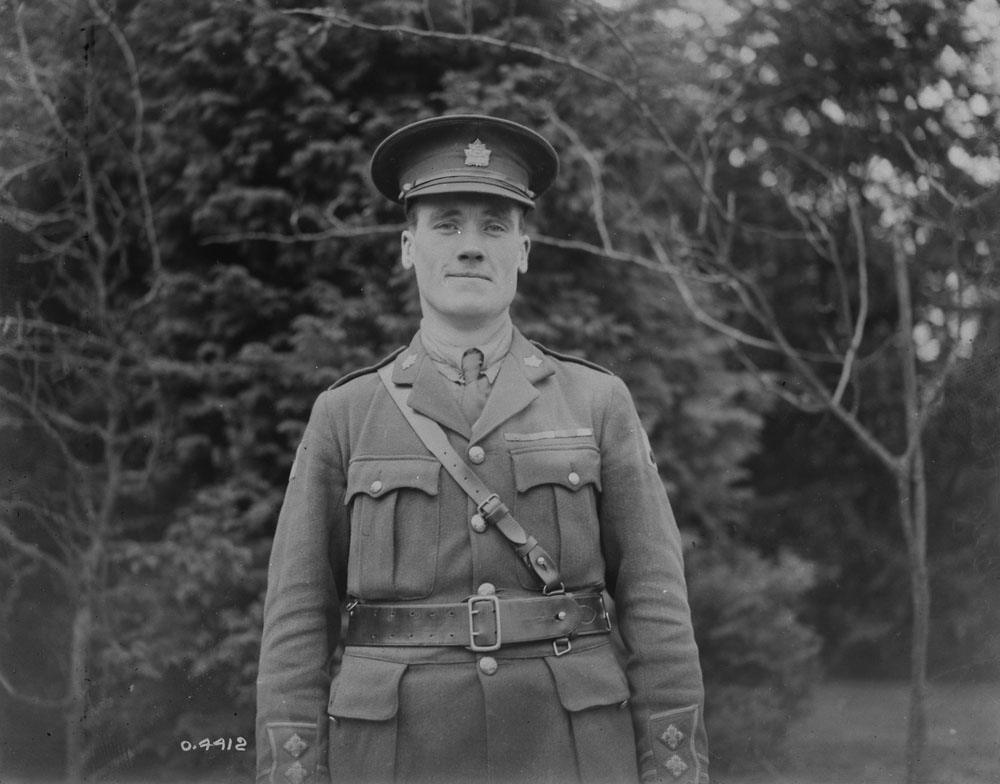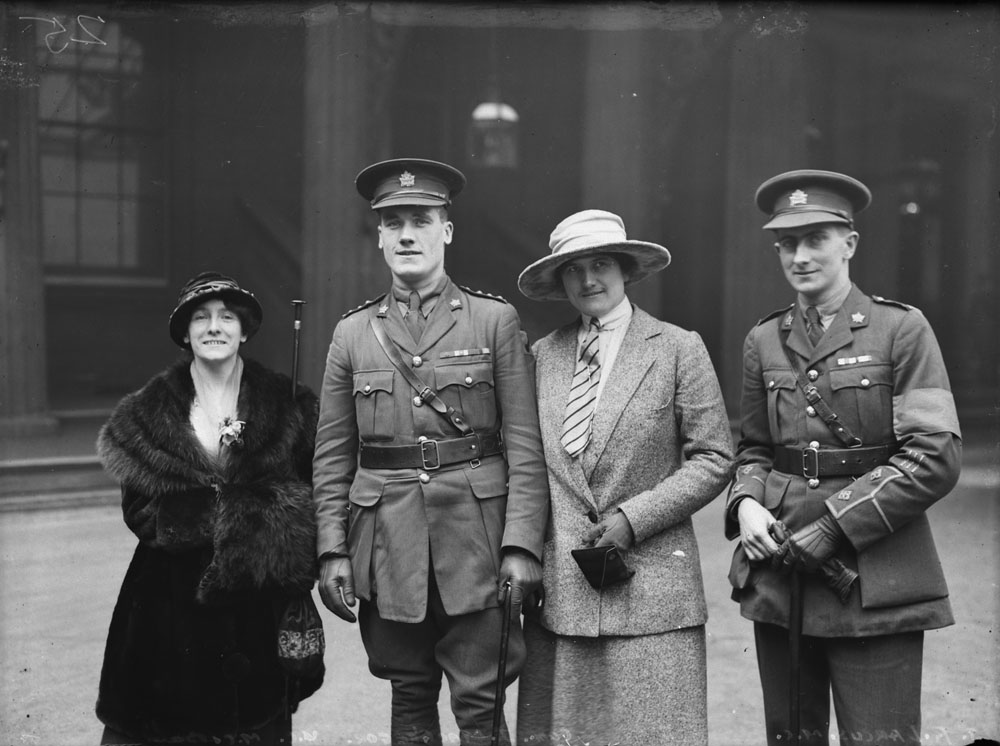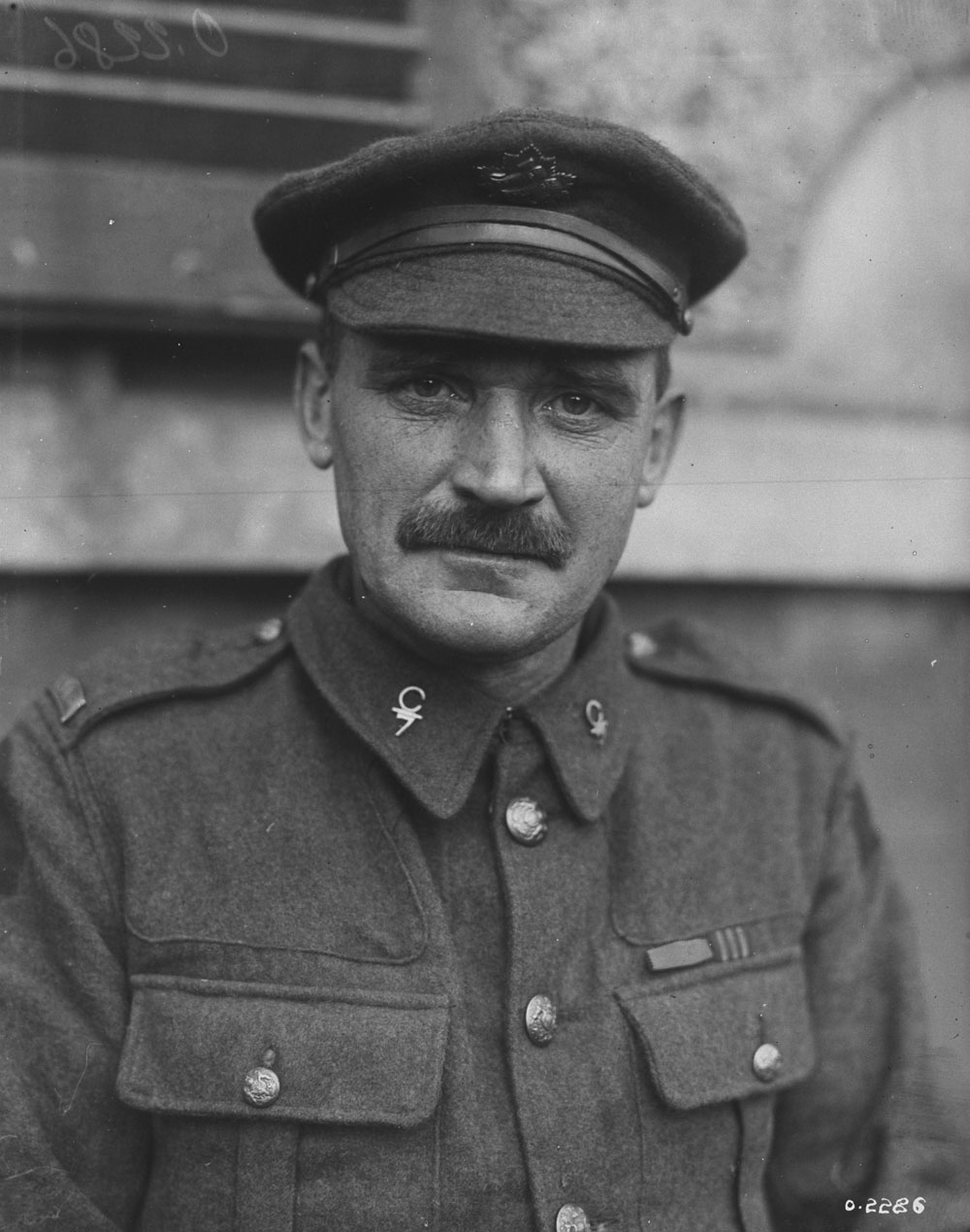John (Jock) MacGregor, VC, MC & Bar, DCM, carpenter, soldier and businessman (born 11 February 1888 in Cawdor, Nairnshire, Scotland; died 9 June 1952 in Powell River, British Columbia). MacGregor was one of Canada’s most decorated servicemen. He joined the 2nd Battalion, Canadian Mounted Rifles during the First World War and rejoined the army again for the Second World War. For his heroic actions in the First World War, MacGregor received the Victoria Cross (VC), two Military Crosses (MC) and the Distinguished Conduct Medal (DCM).

Early Life
John MacGregor was the third child of William and Hanna MacGregor. He grew up on a croft (a small, rented farm) and attended schools in Cawdor and Nairn in Scotland. In 1907, MacGregor was apprenticed to a master carpenter and stone mason; he also served for three years in the Nairn Garrison Artillery.In 1909, MacGregor immigrated to Canada and worked his way westward. In 1913, he settled in the backwoods northeast of Prince Rupert, British Columbia, and began trapping. In early 1914, MacGregor learned that Britain was at war with Germany and immediately set out on snowshoes for Terrace.
When MacGregor arrived at the recruiting office five days later, he was dirty and dishevelled; recruiting officers turned him away as “unfit for duty.” He carried on to Vancouver, cleaned himself up and, on 26 March 1915, became a private in the 11th Canadian Mounted Rifles (CMR).
First World War
In June 1915, John MacGregor sailed to Britain and was stationed at Shorncliffe Camp in Kent. He was transferred to 2nd CMR in July and crossed to the Western Front in September, where his unit was employed in a dismounted role.
By then, the war in Europe had settled into static trench warfare; since fewer mounted troops were required, all CMR units were converted to infantry. In December 1915, the 1st, 2nd, 4th and 5th CMR formed 8th Canadian Infantry Brigade in the newly created 3rd Canadian Division.
MacGregor spent the next few months in the Ypres Salient. In September 1916, 2nd CMR moved to the Somme, near Pozières. On 25 September, MacGregor was promoted from private to sergeant, a testament to his abilities. Shortly afterward, in mid-October, the Canadians began to move to Vimy Ridge.
Valour at Vimy
The Germans had strongly fortified Vimy Ridge and resisted earlier French and British attacks. The Canadian Corps spent the next several months in preparation for their assault on the ridge. On Easter Sunday, 8 April 1917, at 5:30 a.m., all four divisions of the corps attacked together for the first time.
The objective of John MacGregor’s C Company was the Zwischen Stellung trench, some 640 m away. As the supporting artillery barrage began, MacGregor jumped out of his trench and charged forward, exhorting his men to follow. When a German machine gun opened fire on MacGregor’s platoon, he shouted for his men to stay down, attacked the machine-gun post, killed the crew and captured the gun. The 2nd CMR had taken its objective in 30 minutes.
On 17 May, MacGregor became a temporary lieutenant and was awarded the DCM for his actions at Vimy Ridge. Following the capture of the ridge, 2nd CMR was in action at Hill 70 in August and at Passchendaele in October.
Heroism at Hill 70
In mid-December, 2nd CMR returned to the Hill 70 area. On 28 December, John MacGregor commanded two reconnaissance patrols in preparation for future raids. At 1:20 a.m. on 12 January 1918, he led a 23-man raiding party into No Man’s Land, which quickly came under German fire.
MacGregor took a few men, crossed the German wire and stormed the enemy trenches while the remainder of his party provided covering fire. His small group killed several Germans, captured two prisoners and brought back valuable information. For this act, MacGregor was promoted temporary captain and awarded the MC.
After leave in Paris and medical treatment in Britain for pleurisy, MacGregor returned to his unit in June and participated in the closing battles of the war, known as Canada’s Hundred Days.
Courage at Cambrai
In late September 1918, John MacGregor took part in the Battle of Cambrai. Between 29 September and 3 October, he led his company forward under intense fire, knocked out enemy machine guns, killed four enemy soldiers and captured another eight.
In the face of continuing enemy fire, MacGregor reorganized his company, continued the advance and provided valuable support to nearby troops. When enemy resistance stiffened, he rallied the troops and commanded the leading waves against them. MacGregor received the Victoria Cross for these actions.
MacGregor was also recognized for his bravery and initiative in the final days of the war. In November, 2nd CMR were tasked with capturing bridges over the Rhonnelle, Aunelle and Honnelle Rivers before they could be blown up by retreating German forces. Between 5 and 8 November, MacGregor reconnoitred and helped secure bridges over the Honnelle River, allowing allied forces to continue their advance. His actions contributed to the final defeat of the enemy. MacGregor received a bar to his MC for this feat.

Between the Wars
John MacGregor returned to Canada in March 1919 and was back in Prince Rupert on 16 April. He found the return to civilian life difficult, and on 15 July 1921, he joined the North British Columbia Regiment, a local militia unit.
MacGregor bought a boat with a friend and equipped it for fishing. On their first trip, a crewman was pulled overboard and sustained serious injuries. MacGregor immediately cut the expensive fishing lines and headed back to port for medical treatment. Since the crewman had no money, MacGregor remortgaged the boat to pay the injured man’s hospital bills and other expenses.
In 1923, as MacGregor walked along one of the port city’s timber docks, an explosion occurred on a boat. He ran to the burning vessel, jumped aboard it, cut the mooring lines with an axe and pushed the boat away from the dock. MacGregor then hacked a hole in the side of the boat, which caused it to sink, preventing the wooden dock from burning down.
MacGregor suffered serious burns and required hospitalization. While in hospital, he met his future wife, nurse Ethel Flower. The pair married in Vancouver in 1924 and went on to have two sons. Ethel did not want to return to Prince Rupert, so the couple moved to Powell River.
In 1925, the MacGregors and their new son moved into a house that John had built. But he soon left his job as a carpenter at the paper mill because he refused to pay graft to continue employment. (This was a payment demanded by hiring managers in return for job security.) As a result, he had to find work farther away.
1n 1929, on MacGregor’s return from a dinner in London, England, hosted by the Prince of Wales for all VC awardees, the mill gave him his job back and fired the individuals running the graft. The next year, MacGregor became a major in the North British Columbia Regiment and in 1930 became the unit’s second-in-command.
Second World War
On 1 July 1940, John MacGregor joined the 2nd Battalion, Canadian Scottish Regiment (Princess Mary’s) as a private but soon became a major. After time as a company commander in the Victoria unit, he became the battalion’s second-in-command in January 1941. In March 1942, he was promoted lieutenant-colonel and appointed the unit’s commanding officer. When the battalion was disbanded in 1943, MacGregor moved to other posts and was discharged from the army on 11 May 1946.
Postwar Life
John MacGregor returned to Powell River and established a gravel business. By late 1949, he often failed to show up for work due to repeated stomach pains. After initial assessment at a veterans’ hospital found nothing wrong, the doctors sent MacGregor to a mental hospital.
The mental hospital did nothing to help MacGregor and discharged him in December 1950 with the diagnosis of “involutional psychosis” and “a malingerer.” But MacGregor’s condition did not improve, and he was readmitted to the mental hospital in January 1951, only to be discharged shortly afterward.
MacGregor began to work as a carpenter again, but on 22 December 1951 he collapsed from a severe pain in his abdomen. He was flown to a Vancouver hospital, where stomach cancer was discovered. After treatment, the hospital sent him home.
By 1 June 1952, MacGregor’s wife could no longer care for him, and he was admitted to the Powell River Hospital. He died there eight days later and was buried in the Cranberry Lake Cemetery.
Memory
In Powell River, MacGregor Avenue and the MacGregor Building (town hall and library) and are named in his honour. MacGregor’s VC and other medals are on display at the Canadian War Museum in Ottawa.
There are plaques in his honour on Toronto’s Victoria Cross Memorial in York Cemetery and on the British High Commission in Ottawa. His name is also engraved on the Victoria Cross obelisk in Barrie’s Military Heritage Park. On 29 September 2018, on the hundredth anniversary of MacGregor’s VC, his hometown of Nairn dedicated a commemorative memorial stone in his honour at the town’s war memorial.
In 2022, John MacGregor Horne established the John MacGregor Memorial Award in his honour. It is awarded to members of the British Columbia Search and Rescue Association who put themselves in harm’s way to rescue people in dangerous situations.

 Share on Facebook
Share on Facebook Share on X
Share on X Share by Email
Share by Email Share on Google Classroom
Share on Google Classroom






